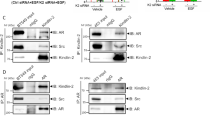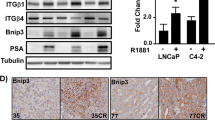Abstract
Aberrant regulation in the adhesive ability of cancer cells is closely associated with their metastatic activity. In this study, we examine the role of ErbB-2 in regulating the adhesive ability of androgen receptor (AR)-positive human prostate cancer (PCa) cells, the major cell population of PCa. Utilizing different LNCaP and MDA PCa2b cells as model systems, we found that ErbB-2 activity was correlated with PYK2 activity and adhesive ability in those cells. Increased ErbB-2 expression or activity in LNCaP C-33 cells enhanced PYK2 activation and cell adhesion, while the high PYK2 activity and the rapid adhesion of LNCaP C-81 cells were decreased by diminishing ErbB-2 expression or activity. Knockdown studies revealed the predominant role of ErbB-2 in regulating LNCaP C-81 cell adhesion. Coimmunoprecipitation showed that C-81 cells had increased interaction between ErbB-2 and PYK2. Elevated ErbB-2 activity in LNCaP cells correlated with increased ERK/MAPK activity and enhanced adhesive ability, which were abolished by the expression of K457A-PYK2 mutant or the treatment of PD98059, a MEK inhibitor. In summary, our data suggested that ErbB-2, via PYK2-ERK/MAPK, upregulates the adhesive ability of AR-positive human PCa cells.
This is a preview of subscription content, access via your institution
Access options
Subscribe to this journal
Receive 50 print issues and online access
$259.00 per year
only $5.18 per issue
Buy this article
- Purchase on Springer Link
- Instant access to full article PDF
Prices may be subject to local taxes which are calculated during checkout








Similar content being viewed by others
References
Avraham H, Park SY, Schinkmann K, Avraham S . (2000). RAFTK/Pyk2-mediated cellular signalling. Cell Signal 12: 123–133.
Chen SJ, Karan D, Johansson SL, Lin FF, Zeckser J, Singh AP et al. (2007). Prostate-derived factor as a paracrine and autocrine factor for the proliferation of androgen receptor-positive human prostate cancer cells. Prostate 67: 557–571.
Dikic I, Dikic I, Schlessinger J . (1998). Identification of a new Pyk2 isoform implicated in chemokine and antigen receptor signaling. J Biol Chem 273: 14301–14308.
Dikic I, Tokiwa G, Lev S, Courtneidge SA, Schlessinger J . (1996). A role for Pyk2 and Src in linking G-protein-coupled receptors with MAP kinase activation. Nature 383: 547–550.
Gumbiner BM . (1996). Cell adhesion: the molecular basis of tissue architecture and morphogenesis. Cell 84: 345–357.
Haier J, Nicolson GL . (2001). Tumor cell adhesion under hydrodynamic conditions of fluid flow. APMIS 109: 241–262.
Hynes NE, Lane HA . (2005). ERBB receptors and cancer: the complexity of targeted inhibitors. Nat Rev Cancer 5: 341–354.
Igawa T, Lin FF, Lee MS, Karan D, Batra SK, Lin MF . (2002). Establishment and characterization of androgen-independent human prostate cancer LNCaP cell model. Prostate 50: 222–235.
Knudsen BS, Miranti CK . (2006). The impact of cell adhesion changes on proliferation and survival during prostate cancer development and progression. J Cell Biochem 99: 345–361.
Lakkakorpi PT, Bett AJ, Lipfert L, Rodan GA, Duong le T . (2003). PYK2 autophosphorylation, but not kinase activity, is necessary for adhesion-induced association with c-Src, osteoclast spreading, and bone resorption. J Biol Chem 278: 11502–11512.
Lev S, Moreno H, Martinez R, Canoll P, Peles E, Musacchio JM et al. (1995). Protein tyrosine kinase PYK2 involved in Ca(2+)-induced regulation of ion channel and MAP kinase functions. Nature 376: 737–745.
Li X, Dy RC, Cance WG, Graves LM, Earp HS . (1999). Interactions between two cytoskeleton-associated tyrosine kinases: calcium-dependent tyrosine kinase and focal adhesion tyrosine kinase. J Biol Chem 274: 8917–8924.
Li X, Earp HS . (1997). Paxillin is tyrosine-phosphorylated by and preferentially associates with the calcium-dependent tyrosine kinase in rat liver epithelial cells. J Biol Chem 272: 14341–14348.
Lin MF, Meng TC, Rao PS, Chang C, Schonthal AH, Lin FF . (1998). Expression of human prostatic acid phosphatase correlates with androgen-stimulated cell proliferation in prostate cancer cell lines. J Biol Chem 273: 5939–5947.
Lipinski CA, Tran NL, Menashi E, Rohl C, Kloss J, Bay RC et al. (2005). The tyrosine kinase pyk2 promotes migration and invasion of glioma cells. Neoplasia 7: 435–445.
Meng TC, Lee MS, Lin MF . (2000). Interaction between protein tyrosine phosphatase and protein tyrosine kinase is involved in androgen-promoted growth of human prostate cancer cells. Oncogene 19: 2664–2677.
Meng TC, Lin MF . (1998). Tyrosine phosphorylation of c-ErbB-2 is regulated by the cellular form of prostatic acid phosphatase in human prostate cancer cells. J Biol Chem 273: 22096–22104.
Pandey P, Avraham S, Kumar S, Nakazawa A, Place A, Ghanem L et al. (1999). Activation of p38 mitogen-activated protein kinase by PYK2/related adhesion focal tyrosine kinase-dependent mechanism. J Biol Chem 274: 10140–10144.
Park SY, Li H, Avraham S . (2006). RAFTK/Pyk2 regulates EGF-induced PC12 cell spreading and movement. Cell Signal 19: 289–300.
Robinson D, He F, Pretlow T, Kung HJ . (1996). A tyrosine kinase profile of prostate carcinoma. Proc Natl Acad Sci USA 93: 5958–5962.
Schlaepfer DD, Mitra SK, Ilic D . (2004). Control of motile and invasive cell phenotypes by focal adhesion kinase. Biochim Biophys Acta 1692: 77–102.
Signoretti S, Montironi R, Manola J, Altimari A, Tam C, Bubley G et al. (2000). Her-2-neu expression and progression toward androgen independence in human prostate cancer. J Natl Cancer Inst 92: 1918–1925.
Slamon DJ, Godolphin W, Jones LA, Holt JA, Wong SG, Keith DE et al. (1989). Studies of the HER-2/neu proto-oncogene in human breast and ovarian cancer. Science 244: 707–712.
Tremblay L, Hauck W, Aprikian AG, Begin LR, Chapdelaine A, Chevalier S . (1996). Focal adhesion kinase (pp125FAK) expression, activation and association with paxillin and p50CSK in human metastatic prostate carcinoma. Int J Cancer 68: 164–171.
Vafa A, Zhang Y, Sikes RA, Marengo SR . (1998). Overexpression of p185erbB2/neu in the NbE prostatic epithelial cell line increases cellular spreading and the expression of integrin alpha6beta1. Int J Oncol 13: 1191–1197.
van der Horst EH, Weber I, Ullrich A . (2005). Tyrosine phosphorylation of PYK2 mediates heregulin-induced glioma invasion: novel heregulin/HER3-stimulated signaling pathway in glioma. Int J Cancer 113: 689–698.
Veeramani S, Yuan TC, Chen SJ, Lin FF, Petersen JE, Shaheduzzaman S et al. (2005). Cellular prostatic acid phosphatase: a protein tyrosine phosphatase involved in androgen-independent proliferation of prostate cancer. Endocr Relat Cancer 12: 805–822.
Wang X, Yang Y, Guo X, Sampson ER, Hsu CL, Tsai MY et al. (2002). Suppression of androgen receptor transactivation by Pyk2 via interaction and phosphorylation of the ARA55 coregulator. J Biol Chem 277: 15426–15431.
Zrihan-Licht S, Fu Y, Settleman J, Schinkmann K, Shaw L, Keydar I et al. (2000). RAFTK/Pyk2 tyrosine kinase mediates the association of p190 RhoGAP with RasGAP and is involved in breast cancer cell invasion. Oncogene 19: 1318–1328.
Acknowledgements
We thank Dr Chawnshang Chang at University of Rochester (Rochester, NY, USA) for the gift of the wt and the K457A mutant of PYK2 cDNAs. We also thank Dr Yaping Tu at Creighton University (Omaha, NE, USA) for providing us with CWR22Rv1 cells, and Dr Ming-Shyue Lee for analysing FAK activation in LNCaP cells. This study was supported in part by NIH grant CA88184, DOD Army PCa program PC050769, Nebraska Research Initiative and UNMC Graduate Student Fellowship
Author information
Authors and Affiliations
Corresponding author
Additional information
Supplementary Information accompanies the paper on the Oncogene website (http://www.nature.com/onc).
Supplementary information
Rights and permissions
About this article
Cite this article
Yuan, TC., Lin, FF., Veeramani, S. et al. ErbB-2 via PYK2 upregulates the adhesive ability of androgen receptor-positive human prostate cancer cells. Oncogene 26, 7552–7559 (2007). https://doi.org/10.1038/sj.onc.1210570
Received:
Revised:
Accepted:
Published:
Issue Date:
DOI: https://doi.org/10.1038/sj.onc.1210570



